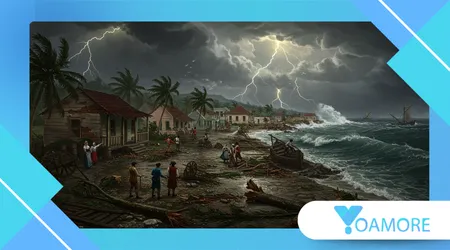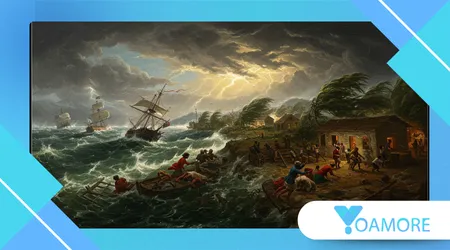The Great Hurricane of 1780: The Deadliest Tropical Cyclone in the Western Hemisphere

The Great Hurricane of 1780 remains the deadliest tropical cyclone ever recorded in the Western Hemisphere, a natural disaster that devastated entire islands, reshaped Caribbean history, and left a legacy of lessons about human vulnerability to extreme weather.
Anúncios
In this article, you’ll explore what happened during that catastrophic event, why it still matters today, and how it connects to modern discussions on climate resilience.
Summary of this article:
- Historical background and impact of the 1780 hurricane.
- Geographical scope and the islands most affected.
- Estimated death toll and the unique historical circumstances.
- Comparison with modern hurricanes and preparedness strategies.
- Lessons for today in disaster management and climate awareness.
A Storm That Altered History
The Great Hurricane of 1780 struck in October 1780, during the height of the American Revolutionary War.
Its fury fell hardest on the Lesser Antilles, particularly Barbados, Saint Lucia, Martinique, and other nearby islands.
Anúncios
Historians estimate that between 22,000 and 27,000 lives were lost in just a few days, a scale of destruction unparalleled in Atlantic hurricane history.
Unlike modern times, when meteorological tracking provides days of warning, islanders then had no advance notice.
Ships were torn apart, coastal villages erased, and plantations destroyed. What makes this storm especially significant is not only its death toll but also its geopolitical timing, as European powers relied on Caribbean colonies for military and economic strength.
To understand the scale, think of the Caribbean in 1780 as a hub of empires—a place where sugar, rum, and naval fleets determined global power.
Losing such critical infrastructure overnight was like shutting down major economic centers today. It didn’t just damage property; it weakened entire nations competing for dominance.
Even now, the story resonates because it illustrates how nature can abruptly shift the trajectory of human ambition.
A single storm, unseen until it arrived, altered military strategies and disrupted trade networks that sustained empires.
+ The 1950s CIA Mind-Control Experiments (Project MKUltra)
Islands That Faced the Full Force

Barbados was among the first to endure the hurricane’s destructive winds. Eyewitness accounts describe how stone buildings collapsed, while entire forests disappeared overnight.
On Saint Lucia and Martinique, casualties mounted as towns were flattened and warships sank in harbors.
The reach of the hurricane extended beyond the immediate Caribbean basin. Vessels associated with the French and British navies were lost, reducing strategic power in the region and indirectly affecting the course of the Revolutionary War.
In many ways, the Great Hurricane of 1780 became not only a humanitarian disaster but also a political turning point.
One striking detail comes from naval records: French ships anchored near Martinique were dragged into shorelines and broken apart, leaving hundreds of sailors trapped at sea.
For commanders, the disaster was more than natural—it was strategic. War efforts suddenly lost vessels without a single shot being fired.
Today, it’s worth comparing these accounts to modern hurricane footage. Just as recent storms have uprooted concrete highways and collapsed skyscrapers, the 1780 hurricane obliterated the strongest structures of its time, erasing the line between man’s achievements and nature’s force.
+ The Explosion of Lake Nyos: A Silent Killer in Africa
Human Toll and Tragic Scale
The human tragedy cannot be overstated. Contemporary records suggest that Barbados alone may have lost around 4,500 people, while Martinique suffered nearly 9,000 deaths.
Other islands recorded similar devastation. The sheer mortality makes this storm unique: according to the U.S. National Hurricane Center, it remains the deadliest hurricane in recorded Atlantic history.
Below is a table summarizing the approximate impact by region, based on historical accounts:
| Island/Region | Estimated Death Toll | Notable Impact |
|---|---|---|
| Barbados | ~4,500 | Destruction of homes and plantations |
| Martinique | ~9,000 | Coastal towns flattened; naval ships destroyed |
| Saint Lucia | ~6,000 | Entire villages lost; massive crop devastation |
| Other islands | ~5,000–7,000 | Structural collapse, widespread famine afterward |
But numbers only reveal part of the picture. Imagine families losing generations in a single storm, entire villages ceasing to exist, and survivors facing famine because crops and livestock vanished.
For many, the aftermath was as deadly as the storm itself, with disease and hunger spreading rapidly.
This scale of mortality highlights the fragility of societies without safety nets. In today’s context, relief agencies, international aid, and organized evacuations exist.
Yet even now, as seen in Puerto Rico after Hurricane Maria, recovery remains painfully slow when infrastructure collapses.
+ Fanfiction as Cultural Preservation: Stories Beyond Borders
Why the Event Still Resonates
Natural disasters often fade from collective memory, but some leave scars too deep to forget. The Great Hurricane of 1780 belongs to that category.
Imagine an entire generation shaped by an event that erased thousands of lives and livelihoods within days.
One powerful analogy helps frame its scale: if such a storm hit the Caribbean today with similar proportional impact, the losses would equal entire modern cities disappearing overnight.
That thought alone highlights both the magnitude of the event and the importance of continued preparedness.
In addition, this storm resonates because it predates modern science. Islanders could not “see” a hurricane forming miles away.
Their only warning was the wind itself. By studying the 1780 hurricane, we’re reminded of the privilege of technology and how costly ignorance once was.
Cultural memory also matters. Some Caribbean oral histories still reference ancient storms as markers of hardship and resilience.
For descendants of survivors, the 1780 hurricane isn’t just history—it’s part of identity, an inherited reminder of endurance.
Comparing the Past with the Present
Unlike 1780, modern technology offers satellites, weather radars, and predictive models.
For example, Hurricane Maria in 2017, though devastating, was tracked days in advance, allowing for at least some preparations.
Maria caused more than 3,000 deaths in Puerto Rico, a tragic number but significantly lower than the toll in 1780 despite larger populations.
The contrast emphasizes how meteorological progress, infrastructure resilience, and international aid reduce—but never eliminate—risk.
According to the National Oceanic and Atmospheric Administration (NOAA), the Atlantic hurricane season has shown a trend toward more intense storms in recent decades, partly due to rising sea surface temperatures (NOAA source).
Yet, preparation is only half the story. Human behavior plays a decisive role. Even when forecasts warn of approaching storms, some communities underestimate the risk or lack the resources to evacuate.
In that sense, lessons from 1780 remain relevant: vulnerability is often tied to inequality and access to safety.
Think of it this way: technology is like a compass. It points in the right direction, but unless people act on it, danger still prevails.
The Great Hurricane of 1780 reminds us that warnings alone don’t save lives—decisive action does.
Examples of Human Resilience
Two modern examples illustrate how lessons from past tragedies shape today’s actions:
- Dominica’s recovery after Hurricane Maria (2017): Instead of rebuilding the same way, the island invested in resilient housing and renewable energy, focusing on becoming the “first climate-resilient nation.”
- New Orleans post-Hurricane Katrina (2005): Engineering upgrades in levee systems transformed the city’s approach to flood defense, preventing a repeat of catastrophic flooding during Hurricane Ida in 2021.
Both examples prove that communities learn not just from their own storms but also from the history of others.
The Great Hurricane of 1780 stands as a reminder that resilience requires more than recovery; it demands transformation.
Resilience also manifests in culture. After every major disaster, music, literature, and storytelling carry the memory forward, preserving warnings for future generations.
Just as Caribbean folklore still recalls storms of the past, today’s documentaries and digital archives ensure that tragedies like Katrina or Maria will not be forgotten.
Lessons from the Great Hurricane of 1780
The lessons drawn from the Great Hurricane of 1780 remain highly relevant:
- Preparedness is key: Without forecasting, 1780’s populations stood defenseless. Today, the challenge lies not in ignorance of storms but in ensuring communities respond effectively.
- Economic vulnerability matters: Just as plantations collapsed then, today’s economies depend on tourism, energy, and supply chains—all fragile during extreme weather events.
- Geopolitical consequences continue: Hurricanes affect not just lives but also political balance. Disasters can destabilize regions, influence migration, and alter trade.
For policymakers, this storm offers a cautionary tale. Climate adaptation strategies must consider not just rebuilding but long-term resilience.
Building codes, urban planning, and social support systems can determine whether a modern storm mirrors the devastation of 1780—or stands as proof of progress.
History doesn’t simply repeat, but it rhymes. Each new hurricane echoes lessons first written centuries ago, urging humanity to stay vigilant.
One Statistic That Speaks Volumes
The World Meteorological Organization (WMO) reports that since 1970, extreme weather events have caused over 2 million deaths worldwide.
That figure, though spread across decades, echoes the concentrated mortality of the Great Hurricane of 1780, proving how nature still dictates global human survival.
Numbers like these force a critical question: are we doing enough to ensure the tragedies of the past remain only in history books?
Frequently Asked Questions (FAQ)
1. Why is the Great Hurricane of 1780 considered unique?
It is the deadliest recorded Atlantic hurricane, with an estimated death toll of up to 27,000, surpassing all other tropical cyclones in the Western Hemisphere.
2. How do modern hurricanes compare to the 1780 storm?
While storms like Katrina (2005) and Maria (2017) were catastrophic, forecasting systems and infrastructure improvements prevented death tolls anywhere near those of 1780.
3. Did the hurricane influence historical events?
Yes. The hurricane weakened French and British naval fleets in the Caribbean, indirectly affecting strategies during the American Revolutionary War.
4. Could a storm of similar strength happen again?
Yes, meteorologists agree such intensity is possible, especially with rising ocean temperatures fueling stronger hurricanes. However, global preparedness and forecasting tools provide significant mitigation potential.
5. Where can I learn more about hurricane history and preparedness?
Authoritative resources include the National Hurricane Center and NOAA’s climate research portals, offering updates on both historical events and modern risk management.
Final Thoughts
The Great Hurricane of 1780 remains more than a historical curiosity—it is a stark reminder of humanity’s fragile coexistence with nature’s power.
By studying this catastrophic event, modern society gains perspective on resilience, vulnerability, and the urgent need for climate adaptation.
If history teaches one clear lesson, it’s this: storms cannot be prevented, but preparedness can transform outcomes. Will today’s societies take those lessons seriously before the next great disaster strikes?
